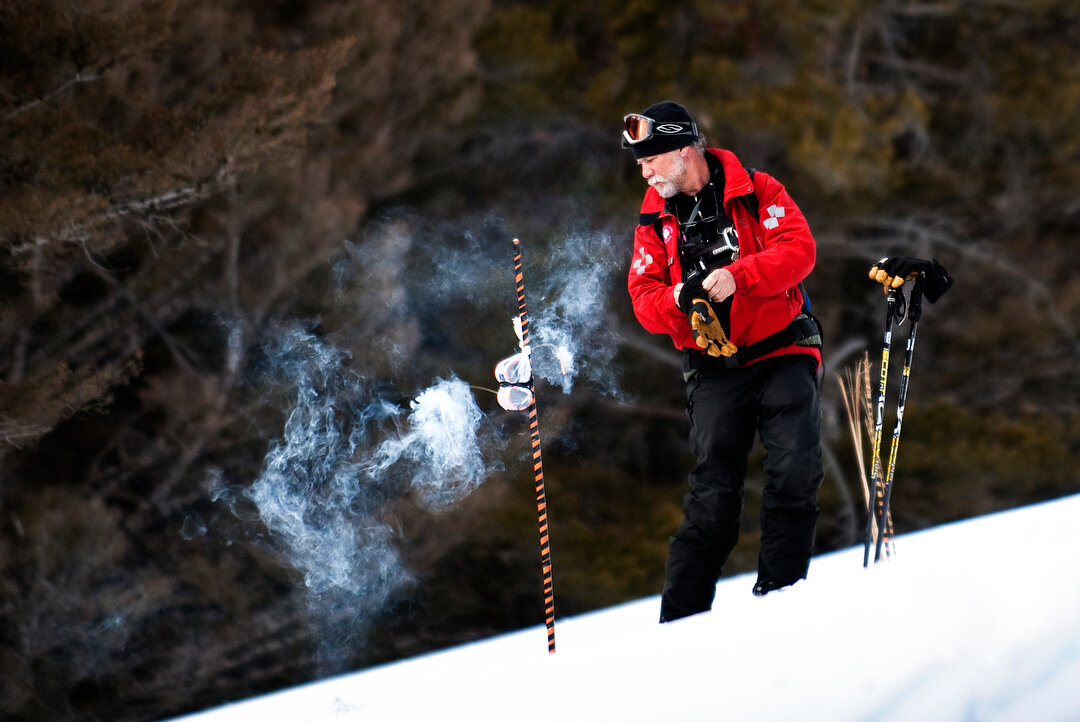Mountaineer and guide Kristoffer Erickson skiing the slopes of La Légère in Chamonix, France.
COLD SCIENCE
Avalanche and snowpack are common concerns in mountain regions. Avalanches can be highly destructive to human life and property, especially in a time when more people are accessing the winter backcountry for recreation. Snowpack affects everything from fresh water supply to communities and agriculture and the risk of wildfire when conditions are dry. This body of photographs is a sample of work conducted by researchers at Montana State University who have carved out a niche in various studies related to snow.
A ski patroller at Bridger Bowl near Bozeman, Montana takes a poma lift to a ridgeline over 9,000ft in elevation before lifts open to perform avalanche mitigation.
A ski patroller ignites a fuse for an explosive device. Explosives have long been used to intentionally trigger avalanches in mountainous regions to prevent uncontrolled avalanches from causing harm to people. As the supply of many types of WWII-era explosive devices are running low, researchers are studying alternatives including the use of sound to trigger slides.
Montana State University researchers Pat Staron, left, and Ed Adams examine a snow field in the southwest Montana backcountry using a thermal camera. This data can help them understand how the melting process and temperature affect conditions that promote avalanches.
Montana State University researchers sample snow crystals in the Subzero Research Laboratory in the university’s college of engineering. The facility is a unique world-class, state-of-the-art suite of facilities used to study snow, ice and the effects of the cold on projects across a range of scientific disciplines.
A researcher in the MSU Subzero facility studies an ice core sample in a temperature-controlled laboratory.
An ice core sample is illuminated by the light from a microscope in a climate-controlled lab where temperatures can be held well below zero degrees Fahrenheit.
Montana State University civil engineering professor and researcher Kevin Hammonds examines an ice core sample in the Subzero Research Facility. Researchers from around the world use the facility to conduct experiments and store ice samples taken from as far away as Antarctica.
A macroscopic photo of a snowflake reveals an intricate, crystal-like structure. The structure and size of snow crystals along with other environmental conditions can tell avalanche experts much about the likelihood of a slope to slide.
Scientists from around the nation gather in Bozeman, Montana during a workshop hosted by Montana State University to study snowpack and avalanche conditions.
Fractures in the top layer of snow are pictured on a mountain slope. Fractures are one of several conditions that translate to snow events that can occur on ski slopes, the backcountry and even the Arctic regions.
An engineering student collects snow samples from a field site at a ski area near Bozeman, Mont. Snow science can span academic disciplines from earth science to engineering as snow is not only an environmental condition but also a mechanical process.
Researchers Ed Adams, left, and Robb Larson pull a mannequin, loaded with sensors, from avalanche debris. The experiment was designed to study the forces on a human body during an avalanche.
A Bridger Bowl ski patroller, lower left, watches a controlled avalanche from a safe vantage point. Ski areas with steep terrain intentionally set off avalanches in the early morning hours before the areas open to mitigate the risk of avalanche to skiers.














